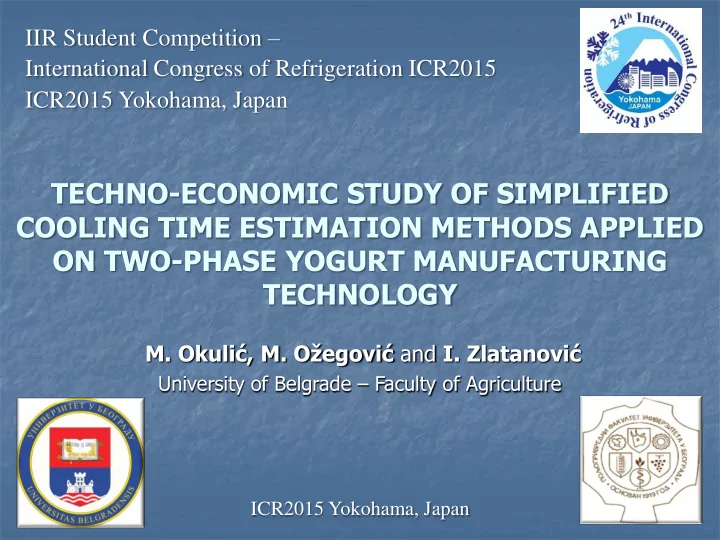

IIR Student Competition – International Congress of Refrigeration ICR2015 ICR2015 Yokohama, Japan TECHNO-ECONOMIC STUDY OF SIMPLIFIED COOLING TIME ESTIMATION METHODS APPLIED ON TWO-PHASE YOGURT MANUFACTURING TECHNOLOGY M. Okulić, M. Ožegović and I. Zlatanović University of Belgrade – Faculty of Agriculture ICR2015 Yokohama, Japan
COOLING TIME ESTIMATION IMPORTANCE ? More efficient and economical operation of the cooling system for specific technology requirements; Smaller capacity of refrigeration systems; Energy savings; Cost-effective production process.
IMPORTANT PARAMETERS Thermo-physical properties of food (heat conductivity, density and heat capacity) Packaging material (size and shape) (plastic cup, carton box, cellophane, ...) Cooling medium (water, air,...) Refrigerant propeties
SIMPLIFIED COOLING TIME CALCULATION METHODS 1. Cooling time estimation method based on f and j factors 2. Cooling time estimation method based on „ Equivalent Heat Transfer Dimensionality “ (EHTD)
Cooling time estimation method based on f and j factors f and j factors represent the slope and j intercept, of the temperature history 2.0 curve. f 1.0 Factor j is a measure of the lag between 0.8 the onset of cooling and the exponential decrease in the temperature of the food. 0.6 Y 0.4 Factor f represents the time required to 0.3 obtain a 90% reduction in the non- 0.2 dimensional temperature difference (Y). T T a Y T T i a 0.1 0 10 20 30 40 50 60 f Y , min. ln 2.303 j - Cooling time
Calculation of f and j factors for irregulary shaped products 3 1 1 – shape factor 2 4 G 0 . 25 L 2 2 8 A A 1 2 A 2 2 2 . 303 L – f factor f 2 M 1 H A 1 L 2 0 . 0388 M j 0 . 892 e 1 – j factor
Cooling time estimation method based on „ Equivalent Heat Transfer Dimensionality “ (EHTD) Cooling time estimation method based on EHTD is based on the comparison of the total heat transfer to the heat transfer through the shortest dimension. 2 3 c L j - Cooling time ln 2 E Y 4 3 Bi 1.85 E - EHTD factor 4 3 1.85 Bi E E 0
Typical diary supply chain scheme Diary Farm Transport (processing factory) Transport Distribution Consumer Retail Transport depots Cold chain
Two-phase yogurt manufacturing technology Pasteurization Reception 30 min at T=85 o C Filtration of the raw milk 10 min at T=95 o C Homogenization Separation mixing at 15 Mpa and cooling to T=43 o C Cream Skim milk Starter culture insertion Standardization at T=43 o C to acheive the desired % of fat content
Small blast freezers Storage cold room
Yogurt palette packaging Small blast freezer interior
CALCULATION RESULTS Estimation m ethod based on f and j factors Input data: Dimension of yogurt cup ( diameter 2∙L and height H ) Ø55 x 63 mm - Shortest distance between cup center and cup surface L=0.0275 m - The minimum cross sectional area containing L A 1 =0.02375 m 2 - The cross sectional area that is orthogonal to A 1 A 2 =0.003465 m 2 - Biot number Bi=1.368 - The geometry index G=0.801 - The characteristic value M 1 2 =1.48 - Factor f f=13169 - Factor j j=0.842 - The fractional unaccomplished temperature difference Y=0.465 - Cooling time: 56.58 minutes
CALCULATION RESULTS Estimation m ethod based on EHTD Input data: Yogurt cup radius L=0.0275 m - Biot number Bi=1.368 - Value of ω ω =1.776 - Form factor for Bi=0 E 0 =2.74 - Form factor for Bi → ∞ E ∞ =2.04 - (second shortest dimension of food item)/(shortest β 1 =1.15 - dimension of food item) (longest dimension of food item)/(shortest dimension of β 2 =1.15 - food item) Factor j j=0.842 - The fractional unaccomplished temperature difference Y=0.465 - Cooling time: 53.11 minutes
The yogurt cup radius variation impact on cooling time
CONCLUSION Simplified cooling time calculation methods represents very usefull and reliable tool for the refrigeration system dimensioning. Dimension, shape and geometry of cooled product has great influence on cooling process. The type and form of packaging must be considered during the product design phase, when the application of these methodes can be of importance. This will bring financial savings in the production process due to the higher energy efficiency of the system.
Recommend
More recommend